JEAN-BAPTIST HUYNH
Huynh’s portrait photography is exceptional, especially the close composition of his subjects, as head shots.

Fig 1
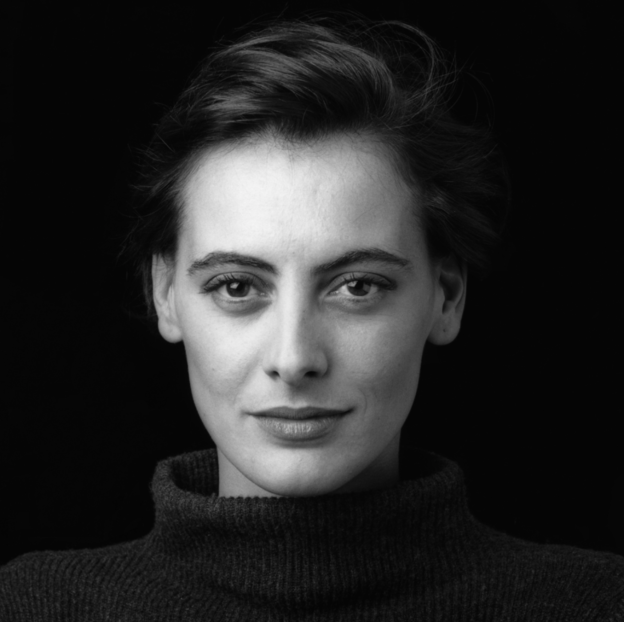
Fig 2
The lighting is bright, yet soft and he still achieves a high contrast in the overall light and shade. The detailing captured in the faces and hair is perfect, bathed in a wonderful soft light. There is just enough details in the black clothes of the sitters before blending perfectly into the background. These images are incredibly striking.
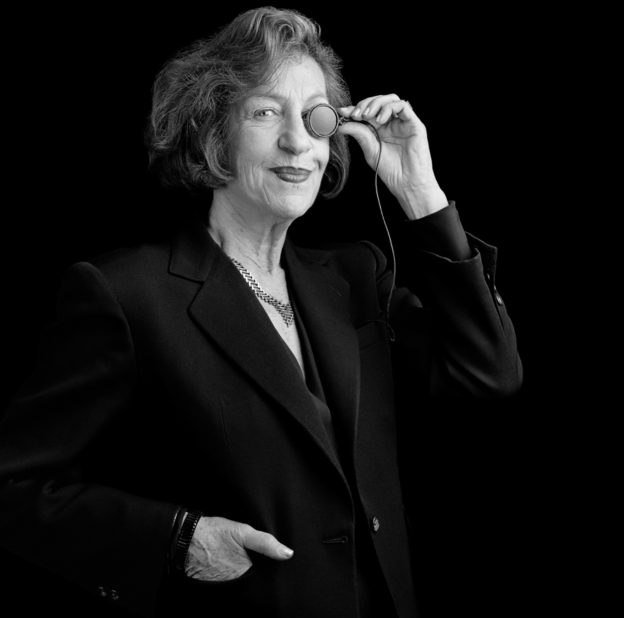
Fig 3
However, I wonder if there has been some post-production work on these images, particularly when you look at fig 3, the brightness in the skin tones, seems disconnected from the depth of blacks achieved in the rest of the image. However, I am also aware that I am highly inexperienced in studio lighting. I will continue my research in a bid to understand how these images are achieved.
For this exercise, I intend to shoot portraits, so my ‘further research’ is all surrounding lighting relevant to portraiture. This is something that I have always been intimidated by, despite previously buying simple entry-level lighting and umbrellas, I have never been successful in my attempts to use them.
LIGHTING ‘PATTERNS’
The standard lighting patterns that are most commonly used in portrait photography, can be described as…
• Split lighting
• Loop lighting
• Rembrandt lighting
• Butterfly lighting
Split lighting (fig 4) is achieved by using a light source directly to the side of the subject’s direction of gaze. This then lights one half of the face, while the other is in relative shade. This can be achieved either with natural light through a window, or with a single light source.

Fig 4
Loop lighting (fig 5) is defined by the creation of a small shadow on the subjects cheek, from their nose. The light source needs to be off to one side and slightly higher than their eye level in order for the shadow to drop downwards slightly. The shadow should be kept quite short, and definitely not join up with the shadows created by their cheeks.

Fig 5
Rembrandt lighting (fig 6) is named after the the famous painter who generally pained his subjects under this type of light. The trick of this lighting style is to have one side of the subjects face in the shadow, albeit for a small triangle of light on their cheek. As opposed to loop lighting, the shadow from the nose should connect with the shadow from the cheek. The aim is to keep the eye in the light, including a catch light if possible. The light source almost needs t be slightly behind the subject, and again, slightly higher up.
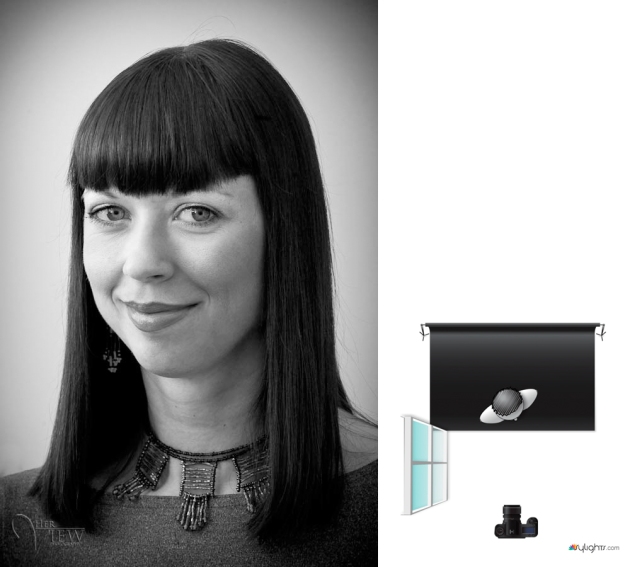
Fig 6
Butterfly lighting (fig 7) is created by placing the light source behind and above the camera, with the sitter facing directly towards the camera. This ensures that the light falls straight onto the subject, creating butterfly-shaped shadows below the cheeks.

Fig 7
LIGHTING ‘STYLES’
Further to the above mentioned patterns of lighting are two styles of lighting. These are defined as either ‘broad’ or ‘short’.
In broad lighting (fig 8), the subject turns the lit side of their face towards the camera i.e. the broad side of the face is lit. “Simply put broad lighting illuminates the largest part of the face showing.” (Digital Photography School, 2017)
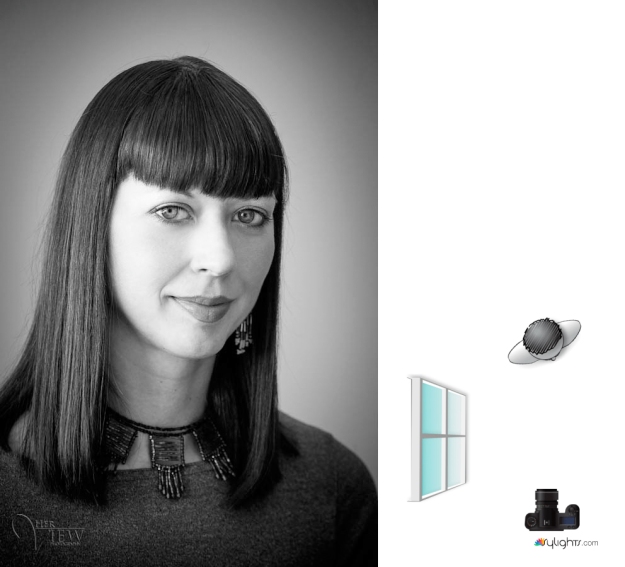
Fig 8
In short lighting, the opposite it true, the subject would turn the lit side of their face away from the camera, i.e. the short side of the face is lit. “Simply put short lighting has shadows on the largest part of the face showing.” (Digital Photography School, 2017)
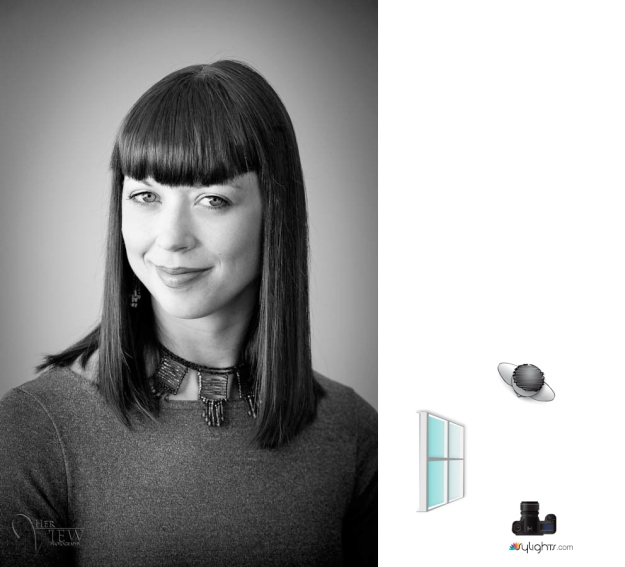
Fig 9
It’s worth noting that broad lighting would accentuate the width of a face, while short lighting does the opposite. These styles should be used to suit the specifics of the subject.
HIGH KEY + LOW KEY LIGHTING
High key lighting essentially describes an image that has predominantly white and light tones (fig 10), whereas low key lighting has more in the way of black and dark tones (fig 11). High key lighting will still include blacks and mid tones, but they will be minimal. Conversely, low key lighting may still have whites and mid tones, but again, these will be minimal.

Fig 10
For obvious reasons, high key lighting generally uses a white background. The aim is to produce very minimal shadows on the subject. The feeling is light and airy, with a sense of optimism. Shooting high key in a studio requires a good set of multiple lights. Not only are you lighting your subject, you also light the background.

Fig 11
Low key lighting is generally shot against a very dark background, with absolutely no light on it at all. There should be a single light source, in order to be very selective with what is picked out with the light. The use of black clothing can greatly accentuate the darkness of the image. Low key lighting creates high contrast and drama. The imagery produced is extremely striking.
The simplicity of this set up is a rather attractive starting point, and I intend to begin my portraits trying to achieve this type of low key image.
CHIAROSCURO
Chiaroscuro is a term associated with low key lighting, where form is defined by the contrast between light and shade. The term was first coined in the Renaissance period with regard to a specific technique of painting, advocated by Rembrandt, Da Vinci and Caravaggio amongst others. However the phrase in now synonymous with this type of lighting in both film and still photography.

Fig 12
Artistically, this style of extreme contrast (fig 12) really hits the mark for me. Less is more. It is completely compelling. I am going to invest some time trying to create lighting similar to this.
YOUSUF KARSH
Yousuf Karsh’s low key, black and white portrait work (fig 13-15) is magnificent – he really captures the personality of his sitters. He doesn’t appear to use any one style of lighting or composition, rather he changes according to who his subjects are. Although light and shade are very important elements in his imagery, the entirety of his subject is generally clear and visible whether in light or shade. My intention is to have much more in the way of shadows, simply revealing a section of my subject at a time.

Fig 13

Fig 14

Fig 15
GEORGE WHEELHOUSE
The style of lighting used by George Wheelhouse is much more akin to my intentions. He allows the light to pick out just enough detail in his subjects (fig 15) without revealing the entire form. I am really drawn to this type of lighting as it allows the medium of photography to take on another form, not one that merely documents the subjects as the eye can already see, but one that marries the truth of the subject with an artistic flair. It is substantially more creative and interesting to me.

Fig 15
References:
Jean-Baptist Huynh. 2017. Jean-Baptist Huynh. [ONLINE] Available at: http://www.jeanbaptistehuynh.com. [Accessed 3 November 2017].
Digital Photography School. 2017. 6 Portrait Lighting Patterns Every Photographer Should Know. [ONLINE] Available at: https://digital-photography-school.com/6-portrait-lighting-patterns-every-photographer-should-know/. [Accessed 3 November 2017].
Image references:
Fig 1: Jean-Baptist Huynh, (2017), untitled [ONLINE]. Available at: http://www.jeanbaptistehuynh.com/oeuvres_9_portraits_.html#PhotoSwipe1509706273492 [Accessed 3 November 2017].
Fig 2: Jean-Baptist Huynh, (2017), untitled [ONLINE]. Available at: http://www.jeanbaptistehuynh.com/oeuvres_9_portraits_.html#PhotoSwipe1509706273492 [Accessed 3 November 2017].
Fig 3: Jean-Baptist Huynh, (2017), untitled [ONLINE]. Available at: http://www.jeanbaptistehuynh.com/oeuvres_9_portraits_.html#PhotoSwipe1509706273492 [Accessed 3 November 2017].
Fig 4: Darlene Hildebrandt, (2017), split-lighting-by-Darlene-Hildebrandt + split lighting pattern [ONLINE]. Available at: https://digital-photography-school.com/6-portrait-lighting-patterns-every-photographer-should-know/ [Accessed 3 November 2017].
Fig 5: Darlene Hildebrandt, (2017), loop-lighting-by-Darlene-Hildebrandt + loop lighting pattern [ONLINE]. Available at: https://digital-photography-school.com/6-portrait-lighting-patterns-every-photographer-should-know/ [Accessed 3 November 2017].
Fig 6: Darlene Hildebrandt, (2017), rembrandt-lighting-by-Darlene-Hildebrandt + split lighting pattern [ONLINE]. Available at: https://digital-photography-school.com/6-portrait-lighting-patterns-every-photographer-should-know/ [Accessed 3 November 2017].
Fig 7: Darlene Hildebrandt, (2017), butterfly-lighting-by-Darlene-Hildebrandt + split lighting pattern [ONLINE]. Available at: https://digital-photography-school.com/6-portrait-lighting-patterns-every-photographer-should-know/ [Accessed 3 November 2017].
Fig 8: Darlene Hildebrandt, (2017), broad-lighting-by-Darlene-Hildebrandt + broad lighting [ONLINE]. Available at: https://digital-photography-school.com/6-portrait-lighting-patterns-every-photographer-should-know/ [Accessed 3 November 2017].
Fig 9: Darlene Hildebrandt, (2017), short-lighting-by-Darlene-Hildebrandt + short lighting [ONLINE]. Available at: https://digital-photography-school.com/6-portrait-lighting-patterns-every-photographer-should-know/ [Accessed 3 November 2017].
Fig 10: Rachael Turner, (2011), untitled [ONLINE]. Available at: http://photoswithrachael.blogspot.ae/2011/10/high-key-photography.html [Accessed 3 November 2017].
Fig 11: Josh Dunlop, (2017), untitled [ONLINE]. Available at: https://expertphotography.com/low-key-photography-dramatic-lighting/ [Accessed 3 November 2017].
Fig 12: Patrick L., (2009), Alexisonfire – Low key [ONLINE]. Available at: https://www.flickr.com/photos/patrickl_/3932305251/ [Accessed 3 November 2017].
Fig 13: Yousuf Karsh, (1945), Frank Lloyd Wright, 1945 [ONLINE]. Available at: https://karsh.org/overview/#31[Accessed 29 November 2017].
Fig 14: Yousuf Karsh, (1956), Walt Disney, 1956 [ONLINE]. Available at: https://karsh.org/overview/#28[Accessed 29 November 2017].
Fig 15: Yousuf Karsh, (1962), Martin Luther King, 1962 [ONLINE]. Available at: https://karsh.org/overview/#5[Accessed 29 November 2017].
Fig 16: George Wheelhouse, (2017), Highland Cattle – Bull on Black [ONLINE]. Available at: http://www.georgewheelhouse.com/galleries/on-black [Accessed 29 November 2017].
Bibliography:
Oleg Ti. 2017. How to do a high key portrait. [ONLINE] Available at: https://profoto.com/us/profoto-stories/how-to-do-a-high-key-portrait. [Accessed 3 November 2017].
Michael Gabriel. 2017. Understanding The Basics of High Key vs. Low Key Lighting. [ONLINE] Available at: https://contrastly.com/understanding-the-basics-of-high-key-vs-low-key-lighting/. [Accessed 3 November 2017].
Adorama. (2016). Low Key Portraits: Take and Make Great Photography with Gavin Hoey. [Online Video]. 24 March 2016. Available from: https://www.youtube.com/watch?v=Ba1Hiq3w3kc. [Accessed: 3 November 2017].
Tony Mack. 2017. Low Key Lighting – How to Shoot Fabulous Dramatic Images. [ONLINE] Available at: http://thefuturephotographer.com/low-key-lighting/. [Accessed 3 November 2017].
Yousuf Karsh. 2017. Yousuf Karsh Master Photographer of the 20th Century. [ONLINE] Available at: https://karsh.org. [Accessed 5 November 2017].
George Wheelhouse. 2017. George Wheeelhouse. [ONLINE] Available at: http://www.georgewheelhouse.com. [Accessed 5 November 2017].